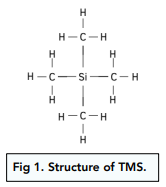Analytical Techniques - NMR Samples and Standards (A-Level Chemistry)
NMR Samples and Standards
Preparing a Sample for NMR
Samples are investigated in dilute solution.
A standard is mixed in with the sample. The purpose of the standard is to provide a reference point to compare the readings in the molecule being detected.
The standard used is tetramethylsilane (TMS) – Si(CH₃)₄. TMS is used for the following reasons:
- Silicon has a very low electronegativity. Silicon’s low electronegativity means that the nuclei in TMS resonate at a very high field strength above that of any ¹H or ¹³C atoms in other molecules. It produces a peak far away from other organic molecules.
- It provides a strong signal. As there are lots of C and H atoms in TMS, 12 hydrogen and 4 carbon atoms, all in the same chemical environment, it provides one strong, sharp signal which is easily detected.
- TMS is inert. TMS is inert so does not react with the sample molecules.
- TMS is cheap. TMS is non toxic and cheap.
- TMS is volatile. TMS has a low boiling point and can therefore be easily removed by distillation and reused again.

The difference between the standard and the peak produced by the sample is called the chemical shift.
The reading for TMS is set to a chemical shift value of zero.





Still got a question? Leave a comment
Leave a comment